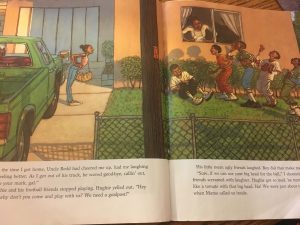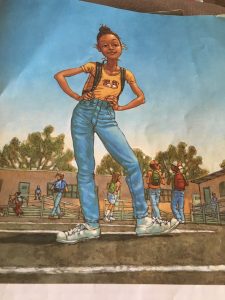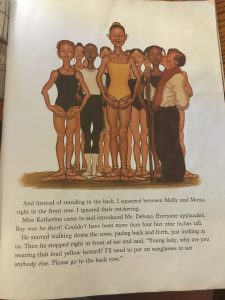![2016-05-16_16.22.46[1]](https://blogs.iwu.edu/lrbmt2016/files/2016/05/2016-05-16_16.22.461-219x300.jpg)
Author: Quentin Blake
Illustrator: Quentin Blake
Publisher/Year: Tate Publishing, 2014
Pages: 27
Genre: Fiction
Analysis:![2016-05-16_16.21.53[1]](https://blogs.iwu.edu/lrbmt2016/files/2016/05/2016-05-16_16.21.531-300x214.jpg)
Five friends are each fantastic in their own way: Angie has exceptional vision, Ollie has spectacular hearing, Simona and Mario have amazing strength, and Eric discovers the power of his voice. During a trip to the countryside, their bus driver becomes ill and faints, forcing the five friends to wander aimlessly in search of help. After Angie spots people on a cliff across the river, quiet little Eric proves to be just as amazing as his friends by using his incredibly loud voice to call for help.
The Five of Us presents a diverse group of characters that many readers can personally identify with; Angie is African American, Ollie wears glasses, Mario uses a wheelchair, Simona is overweight and Hispanic, and Ollie is shy and introverted. Each character and their personal differences are represented in a way that affirms and respects readers who also share those qualities. The five friends are unique in that their special abilities are ones that readers would least expect, though they are still possible (e.g. an overweight girl and handicapped boy having super strength; a shy boy having a loud voice). As such, Blake’s book validates readers who feel doubted or overlooked because of how they look or act. The Five of Us functions as a window by introducing readers to the feelings and experiences of individuals, such as Eric, who take a little more time in realizing their uniqueness. Eric is last to discover his amazing potential, but readers can see that without Eric’s help, the Fantastic Five would not have been rescued by the helicopter. Eric slowly but surely worked up the courage to give a loud cry for help. Finally, The Five of Us acts as a door by encouraging readers to focus on the assets of their peers rather than their inabilities and flaws. Readers are also asked to be more empathetic and understanding towards individuals, like Eric, who develop slower.
Power is equally distributed between the five friends for each has an important power that allows for their eventual rescue. For the five friends, rescue depended on combining their individual powers for the greater good. Although the Fantastic Five represents cultural diversity in and of itself, all other characters in the story are illustrated as white, normal-looking, and able-bodied people.
Blake uses text to celebrate each friend’s individuality. The five friends are all described as “amazing” for the unique abilities they possess (p. 2-3). The text also shows the completeness of Eric’s self-discovery. For most of the story, Eric is nervous and in an effort to prepare himself to speak, all he can muster is “Erm…erm…” (p. 7, 11, 14), until he at last belches out a “HELP” so loud that the exclamation takes up half of the page (p. 20). Blake’s illustrations are also symbolic. As the five friends explore the countryside and look for help, Eric is always drawn lagging behind (on the left in their procession) and also a bit smaller and shorter in size than his friends. Such a portrayal conveys Eric’s perceived weakness in light of his friends who have already showcased their talents. This also allows Eric to both literally and figuratively move forward (to front of group) and provide his unique contribution: a loud cry for help. The text and illustrations, both show how Eric is not to be underestimated. The main ideology presented in The Five of Us is individualism, and how it can be maintained while working as a team and is discovered by humans at different rates. Blake warns against judging people at first glance.

![2016-05-16_16.28.25[1]](https://blogs.iwu.edu/lrbmt2016/files/2016/05/2016-05-16_16.28.251-300x298.jpg)
![2016-05-16_16.29.33[1]](https://blogs.iwu.edu/lrbmt2016/files/2016/05/2016-05-16_16.29.331-300x160.jpg)
![2016-05-16_16.27.04[1]](https://blogs.iwu.edu/lrbmt2016/files/2016/05/2016-05-16_16.27.041-241x300.jpg)
![2016-05-27_11.03.56[1]](https://blogs.iwu.edu/lrbmt2016/files/2016/05/2016-05-27_11.03.561-300x198.jpg)
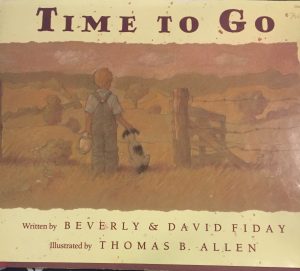 Author(s): Beverly and David Fiday
Author(s): Beverly and David Fiday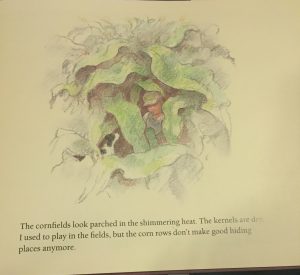
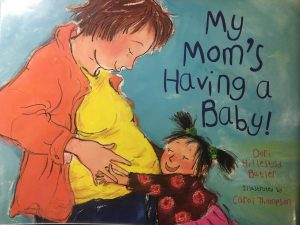 Title: My Mom’s Having a Baby
Title: My Mom’s Having a Baby hat the baby has finger nails, eyes, and ears. It shows the actual size of the embryo at this point in the pregnancy. When Elizabeth wonders how the baby got there, the process of creating a baby is explained. The images include the human anatomy of the female and the male as well as an honest explanation of how the baby got there. The images are pencil drawings with some water color. The use of text bubbles emphasizes the idea that the questions asked in this book are common from children who are expecting to be a big brother or sister. The text in the bubbles also resembles a child’s handwriting, giving it a sense of authenticity.
hat the baby has finger nails, eyes, and ears. It shows the actual size of the embryo at this point in the pregnancy. When Elizabeth wonders how the baby got there, the process of creating a baby is explained. The images include the human anatomy of the female and the male as well as an honest explanation of how the baby got there. The images are pencil drawings with some water color. The use of text bubbles emphasizes the idea that the questions asked in this book are common from children who are expecting to be a big brother or sister. The text in the bubbles also resembles a child’s handwriting, giving it a sense of authenticity.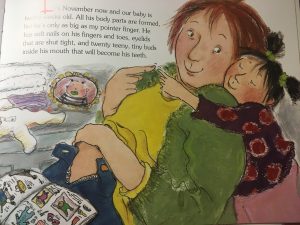
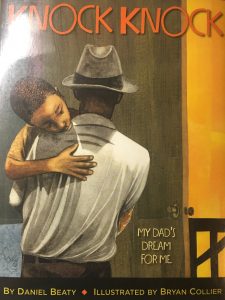 Author: Daniel Beaty
Author: Daniel Beaty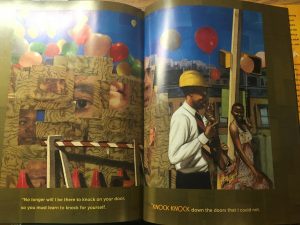 he couldn’t, as well as knock to open the doors to his dreams. This element ties into the game they used to play when he as a child. Ideologically, this book has many important lessons. While it speaks to the children who have lost a parent, it also aims to show hope, the importance of making good decisions, and to not let a past define a future. This book speaks to all children who may have the odds stacked against them. Some people may believe that this book is stereotypical because the father, an African American, is sent to jail. However, I believe that this book is great for all children, regardless of their situation.
he couldn’t, as well as knock to open the doors to his dreams. This element ties into the game they used to play when he as a child. Ideologically, this book has many important lessons. While it speaks to the children who have lost a parent, it also aims to show hope, the importance of making good decisions, and to not let a past define a future. This book speaks to all children who may have the odds stacked against them. Some people may believe that this book is stereotypical because the father, an African American, is sent to jail. However, I believe that this book is great for all children, regardless of their situation.
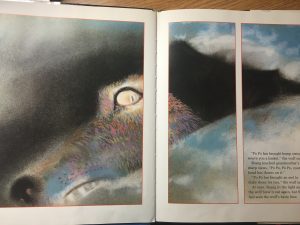
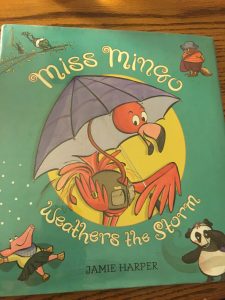
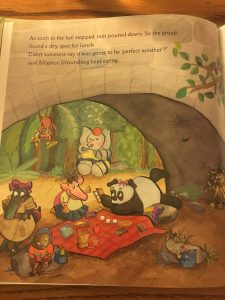
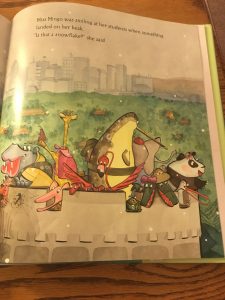

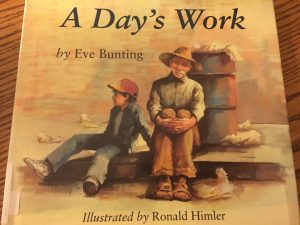
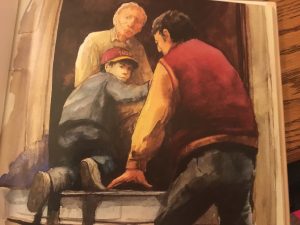
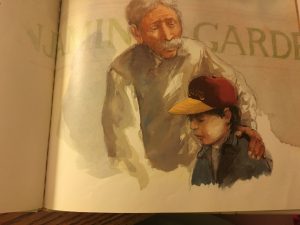
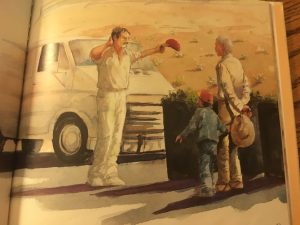
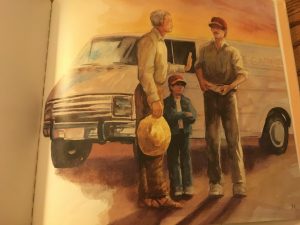
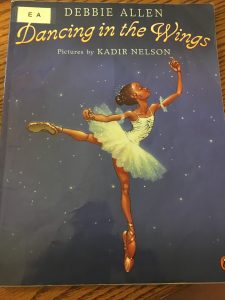 Title: Dancing in the Wings
Title: Dancing in the Wings